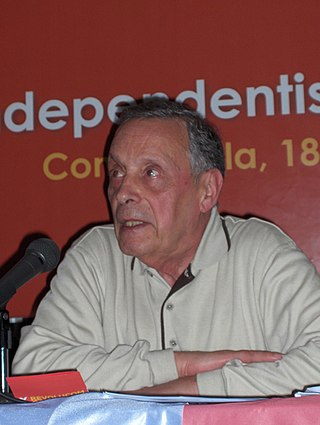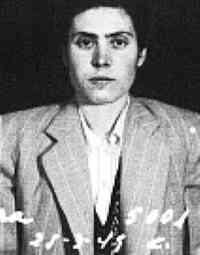
Peniche is a seaside municipality and a city in the Oeste region, in the historical province of Estremadura, and in the Leiria District. It has 26,431 inhabitants, in an area of 77.55 km2. The city itself has a population of about 15,600 inhabitants. The present mayor is Henrique Bertino, elected by the independent coalition GCEPP. The idiomatic expression Friend from Peniche, used to describe someone who wants to receive things at the expense of other without giving anything in return, comes from here.

Álvaro Barreirinhas Cunhal was a Portuguese communist revolutionary and politician. He was one of the major opponents of the dictatorial regime of the Estado Novo. He served as secretary-general of the Portuguese Communist Party (PCP) from 1961 to 1992. He is described as one of the biggest political and intellectual figures of Portugal in the 20th century.
Ângelo Matos Mendes Veloso was a Portuguese politician.

Francisco Martins Rodrigues was a Portuguese anti-Fascist resistant and the founder of the Portuguese Marxist-Leninist Committee in 1964, which was one of the country's first major Marxist-Leninist organizations. Rodrigues was imprisoned numerous times by the PIDE, including a long prison term between 1965 and the Carnation Revolution in April 1974. On January 3, 1960, he, Álvaro Cunhal, and eight others escaped from Peniche Fortress to the great embarrassment of the government.

The Fort of São João Baptista das Berlengas, or simply known as the Fort of the Berlengas, is located off western coast of Portugal, on the largest island of the archipelago of the Berlengas, in the municipality of Peniche in Oeste region. The fortification belonged to a group of defensive military structures meant to protect the municipality located on the coast.

Castelo de Torres Vedras is a castle in Torres Vedras, Portugal. Characterized by a mix of Gothic and Manueline features, it is classified by IGESPAR as a Site of Public Interest.

Lopo de Brito was the second Captain of Portuguese Ceylon. Brito succeeded João da Silveira and was appointed in 1518 under Manuel I of Portugal, he was Captain until 1522. He was succeeded by Fernão Gomes de Lemos.

The Fort Nossa Senhora da Consolação, also known as Fort of Consolação Beach is located on the Atlantic coast of Portugal in the parish of Atouguia da Baleia, in the municipality of Peniche in Leiria District. It was built in 1645 during the Portuguese Restoration War on the initiative of D. Jerónimo de Ataíde, 6th Count of Atouguia and Lord of Peniche.

The Fort of São Bruno is situated on the estuary of the River Tagus in Caxias, Oeiras municipality, near Lisbon in Portugal. It was built in 1647 and became operational in 1649 as part of the construction of a line of forts to control access to Lisbon, which stretched from Cabo da Roca on the Atlantic coast to the Belém Tower near Lisbon. The fort is well preserved, following its original design, and is considered one of the most attractive examples of maritime military architecture on the Portuguese coast. It presently serves as the headquarters of the Associação Portuguesa dos Amigos dos Castelos.
The Fort of King Luís I, also referred to as the Fort of Caxias and the Fort-prison of Caxias, is located in the parish of Caxias, in the municipality of Oeiras in the Lisbon district of Portugal. It presently functions as a prison.

Maria Luísa Costa Dias (1916–1975), was a Portuguese medical doctor and communist activist in opposition to the authoritarian Estado Novo government.

Pedro dos Santos Soares was a Portuguese communist activist who campaigned against the authoritarian Estado Novo government and was arrested on numerous occasions, spending about twelve years in political prisons.
Margarida Tengarrinha was a Portuguese teacher, writer, artist and illustrator. As a member of the Portuguese Communist Party (PCP) she was active as an opponent of the authoritarian Estado Novo regime that governed Portugal between 1926 and 1974, playing a role in document forging and publication of the Party's magazine Avante!. She spent two years in Moscow with the future leader of the PCP, Álvaro Cunhal, and then worked in Bucharest, Romania on a radio station broadcasting to Portugal. After the overthrow of the regime, she became a deputy in the Assembly of the Republic. She later wrote memoirs, taught at a Senior University, illustrated books and exhibited works of art.
Rádio Portugal Livre (RPL) was a radio station in Portuguese run by the Portuguese Communist Party (PCP). From 1962 until 1974 it broadcast on shortwave from Bucharest, Romania in opposition to Portugal's authoritarian Estado Novo regime.

Sofia Ferreira was a prominent member of the Portuguese Communist Party (PCP). She was imprisoned for more than 13 years for her opposition to the Estado Novo regime.
Conceição Matos is a Portuguese communist who campaigned against the authoritarian rule of the Estado Novo regime in the 1960s. She was arrested and subjected to considerable torture.

Dom Martinho de Ataíde, 2nd Count of Atouguia, was a 15th-century Portuguese nobleman and diplomat. In 1455, he was granted the lordship of the Canary Islands, by donation from King Henry IV of Castile, which he later sold to the Count of Viana.

D. Luís de Ataíde, 1st Marquess of Santarém and 3rd Count of Atouguia, was a Portuguese nobleman, military commander and statesman of the 16th century, who stood out for his military feats in the Portuguese State of India. He served as Viceroy of India for two non-subsequent terms.

The Fortress of Sagres, also known as Castle of Sagres or Fort of Sagres, is a military structure, located near the Sagres freguesia, in the municipality of Vila do Bispo, in the Algarve region of Portugal. The fortress was built in the 15th century by order of Portugal's Infante Henry the Navigator. Heavily damaged in the 1755 Lisbon earthquake, it was rebuilt in the late 18th century albeit with significant remodeling. It underwent major renovations in the 1960s and 1990s and in 2010. Inside, the Church of Nossa Senhora da Graça, also built by Henry the Navigator, stands out. The fortress is of great historical importance because of its connection to the history of Henry the Navigator and Portuguese discoveries. In 2018 it was the most visited monument in the Algarve, probably in the entire region south of the Tagus.

Dom Estêvão de Ataíde was a Portuguese soldier, twice governor of Mozambique, who distinguished himself for having successfully defended the Island of Mozambique and its fortress from attacks and sieges by the Dutch, between 1607 and 1608. According to the British historian Edgar Prestage, this defense "saved, not only the fortress itself, but Portuguese rule in the East including East Africa".




















